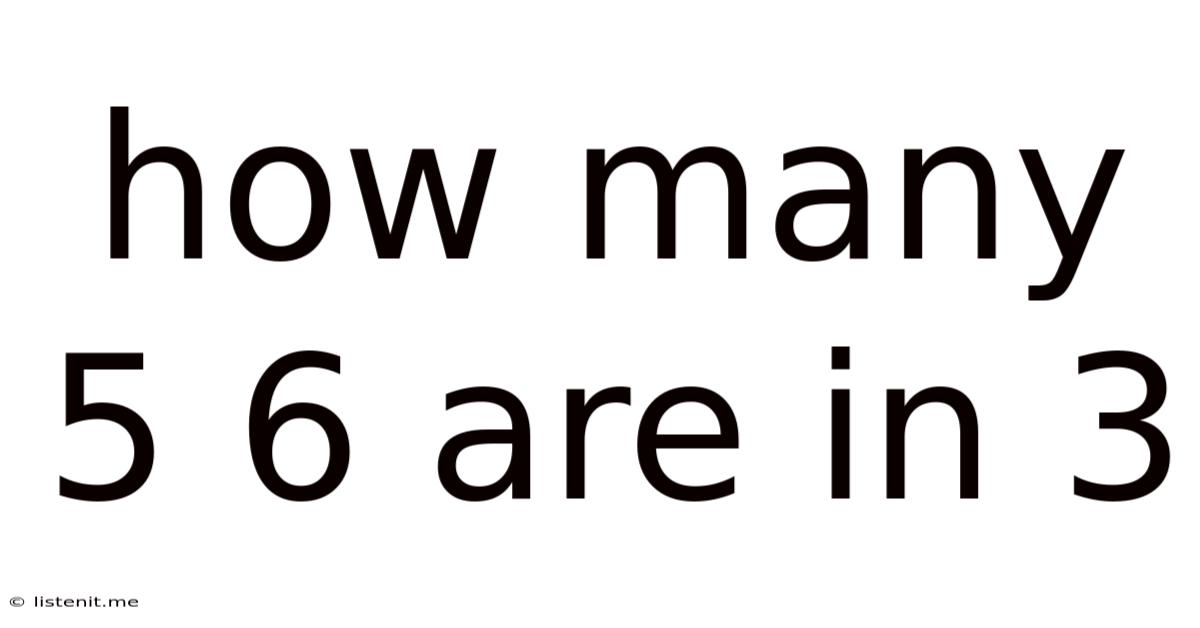How Many 5 6 Are In 3
listenit
May 25, 2025 · 4 min read

Table of Contents
How Many 5/6s Are in 3? Unpacking Fractions and Division
The question, "How many 5/6s are in 3?" might seem deceptively simple at first glance. It's a question that delves into the fundamental concepts of fractions, division, and reciprocal operations. Understanding this seemingly straightforward problem unlocks a deeper understanding of how we manipulate fractions and solve more complex mathematical problems. Let's break it down step-by-step, exploring various methods and illustrating the underlying principles.
Understanding the Question: Fractions as Division
The core of the problem lies in recognizing that "how many X are in Y" is fundamentally a division problem. In this case, we want to find out how many times the fraction 5/6 goes into the whole number 3. This translates mathematically into the division: 3 ÷ (5/6).
Method 1: Converting to Improper Fractions
One common and effective approach is to convert the whole number 3 into an improper fraction with a denominator of 6. Since there are 6/6 in every whole number, 3 can be expressed as 18/6 (3 x 6/6). Now our problem becomes:
(18/6) ÷ (5/6)
Dividing fractions involves multiplying the first fraction by the reciprocal of the second fraction. The reciprocal of 5/6 is 6/5. Therefore:
(18/6) x (6/5) = (18 x 6) / (6 x 5) = 108/30
Simplifying the fraction by dividing both the numerator and the denominator by their greatest common divisor (GCD), which is 6, we get:
108/30 = 18/5
This improper fraction, 18/5, represents the number of times 5/6 goes into 3. To express this as a mixed number, we perform the division:
18 ÷ 5 = 3 with a remainder of 3.
So, the answer is 3 3/5. This means there are 3 full 5/6s and 3/5 of another 5/6 in the number 3.
Method 2: Direct Division using Reciprocals
Alternatively, we can tackle the division directly using reciprocals without converting to improper fractions initially. Recall that dividing by a fraction is the same as multiplying by its reciprocal:
3 ÷ (5/6) = 3 x (6/5)
Now we multiply the whole number 3 by the fraction 6/5:
3 x (6/5) = (3 x 6) / 5 = 18/5
This yields the same improper fraction, 18/5, leading to the same mixed number answer: 3 3/5.
Method 3: Visual Representation
A visual approach can enhance understanding. Imagine three whole units, each divided into six equal parts. The fraction 5/6 represents five of these six parts. We can count how many sets of five parts we can find within our three whole units.
We find three complete sets of 5/6, leaving 3/6 (or 1/2) of a unit remaining. This aligns with the 3 3/5 answer calculated previously, as 3/5 is equivalent to 3/6 or 1/2 of a 5/6 unit.
Expanding the Concept: Real-World Applications
This seemingly basic problem has numerous real-world applications:
-
Baking: If a recipe calls for 5/6 of a cup of sugar for one batch of cookies and you want to make 3 batches, how much sugar do you need? The solution is directly related to this problem.
-
Construction: If a task requires 5/6 of an hour and you have 3 hours available, how many times can you perform this task?
-
Resource Allocation: If a project uses 5/6 of a resource unit and you have 3 units available, how many projects can you complete?
Addressing Potential Confusion: Common Mistakes
A common mistake is to simply divide 3 by 5 and then add the 6 to the result. This is incorrect because it doesn't account for the fractional nature of the divisor (5/6).
Another mistake is to treat the division as (3/1) ÷ (5/6) and incorrectly multiply the numerators and denominators directly, which would lead to the incorrect answer of 18/6 = 3.
Further Exploration: More Complex Fractions
This basic understanding lays the groundwork for tackling more complex problems involving fractions and division. For instance, consider the problem of "How many 2 1/3s are in 5 1/2?" This problem would require converting mixed numbers to improper fractions before applying the division methods discussed above.
Conclusion: Mastering Fraction Division
The question "How many 5/6s are in 3?" isn't just about finding a numerical answer; it's about solidifying the understanding of fundamental mathematical operations, especially fraction division and the application of reciprocals. By using various methods and exploring different approaches, students and learners can build a strong foundation in fraction manipulation, preparing them for more complex mathematical challenges. The ability to approach such problems with multiple perspectives strengthens mathematical reasoning skills and problem-solving abilities. Remember, mastering these foundational concepts is key to success in higher-level mathematics. The visual approach, paired with the numerical methods, provides a comprehensive understanding of the process, making it more intuitive and memorable.
Latest Posts
Latest Posts
-
What Is 46 Divided By 4
May 25, 2025
-
What Is 4 Percent Of 4000
May 25, 2025
-
3 6 7 As An Improper Fraction
May 25, 2025
-
How Many Hours Is 7 Years
May 25, 2025
-
How Many Days Has It Been Since November 23
May 25, 2025
Related Post
Thank you for visiting our website which covers about How Many 5 6 Are In 3 . We hope the information provided has been useful to you. Feel free to contact us if you have any questions or need further assistance. See you next time and don't miss to bookmark.